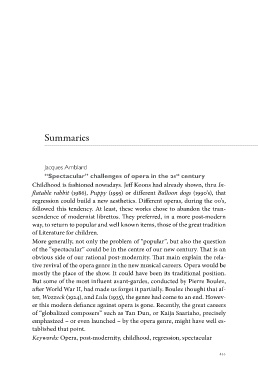Page 435 - Weiss, Jernej, ur. 2019. Vloga nacionalnih opernih gledališč v 20. in 21. stoletju - The Role of National Opera Houses in the 20th and 21st Centuries. Koper/Ljubljana: Založba Univerze na Primorskem in Festival Ljubljana. Studia musicologica Labacensia, 3
P. 435
Summaries
Jacques Amblard
“Spectacular” challenges of opera in the 21st century
Childhood is fashioned nowadays. Jeff Koons had already shown, thru In-
flatable rabbit (1986), Puppy (1995) or different Balloon dogs (1990’s), that
regression could build a new aesthetics. Different operas, during the 00’s,
followed this tendency. At least, these works chose to abandon the tran-
scendence of modernist librettos. They preferred, in a more post-modern
way, to return to popular and well known items, those of the great tradition
of Literature for children.
More generally, not only the problem of “popular”, but also the question
of the “spectacular” could be in the centre of our new century. That is an
obvious side of our rational post-modernity. That main explain the rela-
tive revival of the opera genre in the new musical careers. Opera would be
mostly the place of the show. It could have been its traditional position.
But some of the most influent avant-gardes, conducted by Pierre Boulez,
after World War II, had made us forget it partially. Boulez thought that af-
ter, Wozzeck (1924), and Lulu (1935), the genre had come to an end. Howev-
er this modern defiance against opera is gone. Recently, the great careers
of “globalized composers” such as Tan Dun, or Kaija Saariaho, precisely
emphasized – or even launched – by the opera genre, might have well es-
tablished that point.
Keywords: Opera, post-modernity, childhood, regression, spectacular
433
Jacques Amblard
“Spectacular” challenges of opera in the 21st century
Childhood is fashioned nowadays. Jeff Koons had already shown, thru In-
flatable rabbit (1986), Puppy (1995) or different Balloon dogs (1990’s), that
regression could build a new aesthetics. Different operas, during the 00’s,
followed this tendency. At least, these works chose to abandon the tran-
scendence of modernist librettos. They preferred, in a more post-modern
way, to return to popular and well known items, those of the great tradition
of Literature for children.
More generally, not only the problem of “popular”, but also the question
of the “spectacular” could be in the centre of our new century. That is an
obvious side of our rational post-modernity. That main explain the rela-
tive revival of the opera genre in the new musical careers. Opera would be
mostly the place of the show. It could have been its traditional position.
But some of the most influent avant-gardes, conducted by Pierre Boulez,
after World War II, had made us forget it partially. Boulez thought that af-
ter, Wozzeck (1924), and Lulu (1935), the genre had come to an end. Howev-
er this modern defiance against opera is gone. Recently, the great careers
of “globalized composers” such as Tan Dun, or Kaija Saariaho, precisely
emphasized – or even launched – by the opera genre, might have well es-
tablished that point.
Keywords: Opera, post-modernity, childhood, regression, spectacular
433


